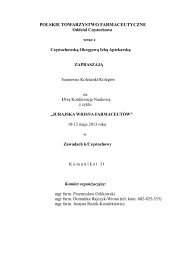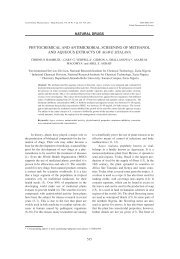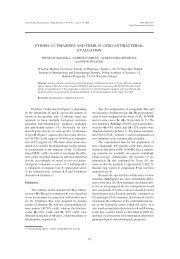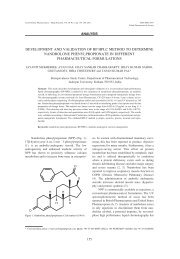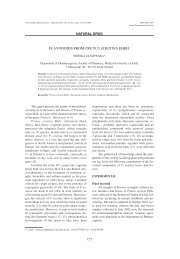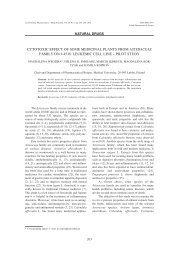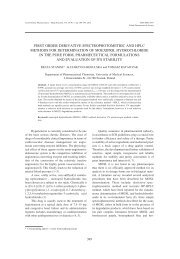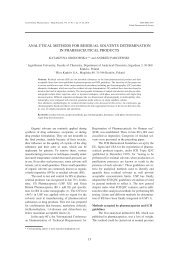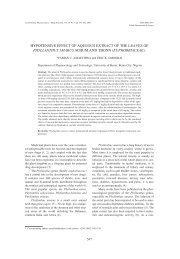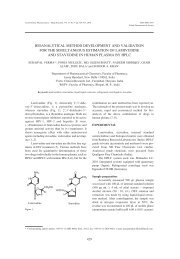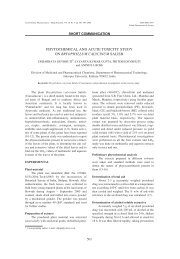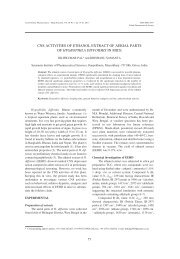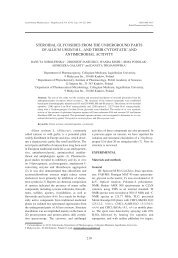indirect spectrofluorimetric determination of mosapride citrate in ...
indirect spectrofluorimetric determination of mosapride citrate in ...
indirect spectrofluorimetric determination of mosapride citrate in ...
Create successful ePaper yourself
Turn your PDF publications into a flip-book with our unique Google optimized e-Paper software.
Acta Poloniae Pharmaceutica ñ Drug Research, Vol. 66 No. 6 pp. 605ñ610, 2009 ISSN 0001-6837<br />
Polish Pharmaceutical Society<br />
Mosapride <strong>citrate</strong> (MC), 4-am<strong>in</strong>o-5-chloro-2ethoxy-{N-[4-(p-fluorobenzyl)-2-morphol<strong>in</strong>yl]<br />
methyl}-benzamide, is a potent gastroprok<strong>in</strong>etic<br />
drug and it is used <strong>in</strong> gastro<strong>in</strong>test<strong>in</strong>al symptoms<br />
associated with chronic gastritis. MC is not yet <strong>of</strong>ficial<br />
<strong>in</strong> any Pharmacopeia but there are several publications<br />
which describe methods for the <strong>determ<strong>in</strong>ation</strong><br />
<strong>of</strong> <strong>mosapride</strong> <strong>citrate</strong> <strong>in</strong> pure and <strong>in</strong> dosage<br />
forms. Most <strong>of</strong> the proposed methods for <strong>mosapride</strong><br />
<strong>citrate</strong> analysis are HPLC (1) and spectrophotometric<br />
methods (2, 3).<br />
The lum<strong>in</strong>escence sensitization <strong>of</strong> lanthanides<br />
(Ln) <strong>in</strong> their complex compounds with organic ligands<br />
is widely used for the <strong>determ<strong>in</strong>ation</strong> <strong>of</strong> drugs:<br />
fluoroqu<strong>in</strong>olones (4), tetracycl<strong>in</strong>e (5), non-steroidal<br />
anti-<strong>in</strong>flammatory preparations (6), catecholam<strong>in</strong>es<br />
(7) <strong>in</strong> the dosed forms and <strong>in</strong> various biological fluids.<br />
In the last few years the possibility <strong>of</strong> analytical<br />
use <strong>of</strong> the lanthanide ions lum<strong>in</strong>escence sensitization<br />
effect as well as their decrease/enhancement<br />
effects by some <strong>in</strong>organic and organic anions, has<br />
been <strong>of</strong> special <strong>in</strong>terest (8).<br />
In this paper we have utilized the enhancement<br />
effect <strong>of</strong> sensitized lum<strong>in</strong>escence by <strong>citrate</strong> ions for<br />
the <strong>determ<strong>in</strong>ation</strong> <strong>of</strong> MC, which is not an Ln lum<strong>in</strong>escence<br />
sensitizer.<br />
ANALYSIS<br />
INDIRECT SPECTROFLUORIMETRIC DETERMINATION OF MOSAPRIDE<br />
CITRATE IN PHARMACEUTICAL FORMULATIONS<br />
DARYA ALEKSANDROVA, YULIA SCRIPINETS, and ALLA YEGOROVA *<br />
A.V. Bogatsky Physico-chemical Institute <strong>of</strong> the National Academy <strong>of</strong> Sciences <strong>of</strong> Ukra<strong>in</strong>e, 86<br />
Lustdorfskaya doroga, Odessa, 65080, Ukra<strong>in</strong>e<br />
Abstract: New europium complexes <strong>of</strong> 3-oxo-1-hydroxy-qu<strong>in</strong>ol<strong>in</strong>e-2-carboxylic acid amide derivatives (L 1-<br />
L 3), which are highly lum<strong>in</strong>escent and do not require lum<strong>in</strong>escence enhancers are reported. The lum<strong>in</strong>escence<br />
<strong>in</strong>tensity <strong>of</strong> the Eu-L 1- 3 complexes was enhanced by the addition <strong>of</strong> <strong>citrate</strong> ions <strong>in</strong> water solution. A sensitive<br />
lum<strong>in</strong>escence enhancement system was developed for the <strong>determ<strong>in</strong>ation</strong> <strong>of</strong> <strong>citrate</strong> ions on the base <strong>of</strong> Eu-9-fluoro-1-hydroxy-5-methyl-3-oxo-6,7-dihydro-3H,5H-pyrido[3,2,1-ij]qu<strong>in</strong>ol<strong>in</strong>e-2-carboxylic<br />
acid (2-piperaz<strong>in</strong>-1yl-ethyl)-amide<br />
(L 1) complex. This effect was applied to the <strong>determ<strong>in</strong>ation</strong> <strong>of</strong> the drug, which is not a lanthanide<br />
lum<strong>in</strong>escence sensitizer. The EuñL 1ñ Cit complex with a componentsí ratio 1:1:2 was proposed to be used as<br />
the analytical form for the lum<strong>in</strong>escence <strong>determ<strong>in</strong>ation</strong> <strong>of</strong> drug ñ <strong>mosapride</strong> <strong>citrate</strong>. The calibration curve is l<strong>in</strong>ear<br />
<strong>in</strong> the range <strong>of</strong> 1.0-25.0 µg/mL <strong>of</strong> <strong>mosapride</strong> <strong>citrate</strong> (LOD is 0.35 µg/mL). This method was applied for the<br />
<strong>determ<strong>in</strong>ation</strong> <strong>of</strong> <strong>mosapride</strong> <strong>citrate</strong> <strong>in</strong> dosage form - tablets ìMosid MTî ñ 2.5 mg.<br />
Keywords: <strong>mosapride</strong> <strong>citrate</strong>; lum<strong>in</strong>escence enhancement; europium (III)<br />
* Correspond<strong>in</strong>g author: e-mail: yegorova@<strong>in</strong>terchem.com.uahotmail.com.<br />
605<br />
Mosapride <strong>citrate</strong> (MC)<br />
The aim <strong>of</strong> this study was to develop a simple,<br />
rapid, precise and sensitive method for the <strong>determ<strong>in</strong>ation</strong><br />
<strong>of</strong> MC <strong>in</strong> pharmaceutical formulations without<br />
the need <strong>of</strong> extraction or heat<strong>in</strong>g. This method is<br />
based on the europium complex with the ligand - 9fluoro-1-hydroxy-5-methyl-3-oxo-6,7-dihydro-<br />
3H,5H-pyrido[3,2,1-ij]qu<strong>in</strong>ol<strong>in</strong>e-2-carboxylic acid<br />
(2-piperaz<strong>in</strong>-1-yl-ethyl)-amide as a lum<strong>in</strong>escence<br />
probe.<br />
EXPERIMENTAL<br />
Apparatus<br />
Lum<strong>in</strong>escence and excitation spectra and lifetimes<br />
were measured with a Solar lum<strong>in</strong>escence<br />
spectrometer (Belorussia) and an Am<strong>in</strong>co-Bowman<br />
Series 2 (SLMñAm<strong>in</strong>co, Rochester, New York)<br />
spectrometer with a 150-W xenon lamp. All <strong>of</strong> the
606 DARYA ALEKSANDROVA et al.<br />
measurements were made at room temperature<br />
(21ñ23 O C). The pH values <strong>of</strong> solutions were measured<br />
on Lab 850 pH meter (Schott Instruments<br />
GmbH, Germany) with a glass electrode.<br />
Absorption spectra were recorded on a UV-2401 PC<br />
(Shimadzu) spectrophotometer.<br />
MATERIALS AND METHODS<br />
A standard 0.1 M solution <strong>of</strong> europium(III)<br />
chloride was prepared from a high purity oxide. The<br />
concentration <strong>of</strong> the metal was determ<strong>in</strong>ed by complexometric<br />
titration with Arsenazo I as the <strong>in</strong>dicator.<br />
The ligands 3-oxo-1-hydroxyqu<strong>in</strong>ol<strong>in</strong>e-2-carboxylic<br />
acid amide derivatives (L 1 ñ L 3) (Table 1)<br />
were synthesized as described elsewhere (9). The<br />
standard solutions <strong>of</strong> reagents (1◊10 ñ3 M) were prepared<br />
by dissolv<strong>in</strong>g accurate weights <strong>of</strong> the solid<br />
compounds <strong>in</strong> water.<br />
The standard solution <strong>of</strong> sodium <strong>citrate</strong> (1◊10 -3<br />
M) was obta<strong>in</strong>ed by dissolution <strong>of</strong> accurately<br />
weighed salt <strong>in</strong> water.<br />
A standard solution <strong>of</strong> <strong>mosapride</strong> <strong>citrate</strong>, 1.0<br />
mg/mL, was obta<strong>in</strong>ed by dissolv<strong>in</strong>g 50 mg <strong>in</strong> 30 mL<br />
<strong>of</strong> water, adjust<strong>in</strong>g the pH to 7.5 with 0.1 M NaOH,<br />
and dilut<strong>in</strong>g to 50 mL. A work<strong>in</strong>g standard solution<br />
<strong>of</strong> <strong>mosapride</strong> <strong>citrate</strong> was obta<strong>in</strong>ed by dilution with<br />
the same solvent to f<strong>in</strong>al concentration <strong>of</strong> 100<br />
µg/mL.<br />
A urothrop<strong>in</strong> buffer was prepared by dissolv<strong>in</strong>g<br />
40.0 g <strong>of</strong> urothrop<strong>in</strong> <strong>in</strong> water, adjust<strong>in</strong>g the pH<br />
to 7.5 with HCl, and mak<strong>in</strong>g up the volume to 100<br />
mL.<br />
A solution <strong>of</strong> ruthenium complex [Ru (2,2 í -<br />
dipyridyl) 3]Cl 2 ◊ 6 H 2O (Fluka) was prepared <strong>in</strong> distilled<br />
water.<br />
All <strong>of</strong> the used chemicals were <strong>of</strong> analytical<br />
grade or chemically pure, dissolved <strong>in</strong> doubly-distilled<br />
water.<br />
Table 1. Spectroscopic and lum<strong>in</strong>escence properties <strong>of</strong> reagents * and their complexes with europium (C Eu = 1 ◊ 10 -4 M; C L = 5 ◊ 10 -5 M;<br />
pH 7.5)<br />
No. Reagent<br />
T*, λ * ,<br />
ε * ×104 λexc, Eu:L = 1:1<br />
[cm-1 ] [nm] [nm] F τ, [µs]<br />
1 9-fluoro-1-hydroxy-5-methyl- 344 0.42<br />
3-oxo-6,7-dihydro-3H,5H- 21010 292 1.38 318 0.018 315<br />
pyrido[3,2,1-ij]qu<strong>in</strong>ol<strong>in</strong>e-2- 235 3.33<br />
carboxylic acid (2-piperaz<strong>in</strong>-1yl-ethyl)-amide<br />
2 9-fluoro-1-hydroxy-5-methyl- 342 0.47<br />
3-oxo-6,7-dihydro-3H,5H- 21100 292 1.43 307 0.015 380<br />
pyrido[3,2,1-ij]qu<strong>in</strong>ol<strong>in</strong>e-2- 235 3.42<br />
carboxylic acid (3-piperid<strong>in</strong>-1yl-propyl)-amide<br />
3 9-fluoro-1-hydroxy-5-methyl- 347 0.55<br />
3-oxo-6,7-dihydro-3H,5H- 20510 291 1.67 306 0.002 310<br />
pyrido[3,2,1-ij]qu<strong>in</strong>ol<strong>in</strong>e-2- 235 4.06<br />
carboxylic acid (2-ethylam<strong>in</strong>oethyl)-amide
Figure 1. Fluorescence decay curves for sensitized europium lum<strong>in</strong>escence<br />
<strong>of</strong> Eu(III)-L 1 complex <strong>in</strong> the presence <strong>of</strong> various concentrations<br />
<strong>of</strong> <strong>citrate</strong> ions, M: 1 ñ 0; 2 ñ 1◊10 -5 ; 3 ñ 3◊10 -5 ; 4 ñ 5◊10 -5<br />
(C Eu = 1 ◊ 10 -4 M; C L1 = 5◊10 -5 M; pH 7.5).<br />
Figure 2. Excitation (a) and emission (b) spectra <strong>of</strong> Eu(III)-L 1<br />
complex <strong>in</strong> the presence <strong>of</strong> different concentrations <strong>of</strong> <strong>mosapride</strong><br />
<strong>citrate</strong> (C Eu = 1 ◊ 10 -4 M; C L1 = 5 ◊ 10 -5 M; pH 7.5; λ ex = 318 nm,<br />
λ em = 612 nm).<br />
Indirect <strong>spectr<strong>of</strong>luorimetric</strong> <strong>determ<strong>in</strong>ation</strong> <strong>of</strong> <strong>mosapride</strong>... 607<br />
Figure 3. Dependence <strong>of</strong> the lum<strong>in</strong>escence <strong>in</strong>tensity <strong>of</strong> the Eu(III)-<br />
L 1 complex on pH (C Eu = 1 ◊ 10 -4 M, C L = 5 ◊ 10 -5 M; pH 7.5).<br />
Figure 4. Calibration curve for <strong>mosapride</strong> <strong>citrate</strong> <strong>determ<strong>in</strong>ation</strong><br />
(C Eu = 1 ◊ 10 -4 M, C L = 5 ◊ 10 -5 M; pH 7.5).<br />
Construction <strong>of</strong> calibration curve<br />
Aliquots <strong>of</strong> 0.1, 0.2, 0.5, 0.7, 1.0, 1.5, 2.0 and<br />
2.5 mL <strong>of</strong> a work<strong>in</strong>g solution <strong>of</strong> <strong>mosapride</strong> <strong>citrate</strong><br />
(100 mg/mL) were placed <strong>in</strong> 10 mL volumetric<br />
flasks. One mL <strong>of</strong> a work<strong>in</strong>g 1◊10 -3 M europium<br />
chloride solution, 0.5 mL <strong>of</strong> a standard, 1◊10 -3 M<br />
reagent solution (L) and 0.5 mL <strong>of</strong> urothrop<strong>in</strong> buffer<br />
were added to each flask. Simultaneously, a blank<br />
solution conta<strong>in</strong><strong>in</strong>g all the components except<br />
<strong>mosapride</strong> <strong>citrate</strong> was prepared. The solutions were<br />
diluted to volume with water and stirred. After 5 m<strong>in</strong><br />
the <strong>in</strong>tensity <strong>of</strong> lum<strong>in</strong>escence was measured at λ em =<br />
612 nm (λ exc = 318 nm).
608 DARYA ALEKSANDROVA et al.<br />
Table 2. Summary <strong>of</strong> validation parameters<br />
Parameters<br />
Results <strong>of</strong><br />
<strong>mosapride</strong> <strong>citrate</strong><br />
L<strong>in</strong>earity range 1.0-25.0 µg/mL<br />
Limit <strong>of</strong> detection (LOD) 0.35 µg/mL<br />
Correlation coefficient (r) 0.99978<br />
Accuracy (n = 6)<br />
Precision<br />
99.5 %<br />
Inter-day (n = 10) 2.1 %<br />
Intra-day (n = 10) 3.7 %<br />
Specificity specific<br />
Table 3. Recovery <strong>of</strong> <strong>mosapride</strong> <strong>citrate</strong> <strong>in</strong> model solutions (n = 6, p = 0.95)<br />
Label claim Amount Amount Amount Recovery RSD,<br />
(mg/tablet) added (%) added (mg) found(mg) (%) %<br />
80 2.0 1.97 ± 0.09 98.5 4.5<br />
Mosapride 100 2.5 2.53 ± 0.10 101.2 3.8<br />
<strong>citrate</strong> 98.7<br />
2.5 120 3.0 2.96 ± 0.11 Average recovery:<br />
99.5<br />
3.5<br />
Table 4. Determ<strong>in</strong>ation <strong>of</strong> <strong>mosapride</strong> <strong>citrate</strong> <strong>in</strong> tablets ìMOSID<br />
MTî ñ 2.5 mg (n = 5, p = 0.95)<br />
Batch No. Found [mg] RSD [%]<br />
3566002 2.49±0.09 2.9<br />
3566003 2.59±0.05 1.5<br />
3566005 2.56±0.06 2.0<br />
Procedure for commercial tablets ìMosid MTî -<br />
2.5 mg<br />
Twenty tablets <strong>of</strong> an analyzed drug were<br />
weighed to obta<strong>in</strong> the average tablet weight, and<br />
were then powdered. The powder equivalent to 5.0<br />
mg <strong>of</strong> the active <strong>in</strong>gredient was placed <strong>in</strong>to a 50 mL<br />
volumetric flask, mixed with 30 mL <strong>of</strong> water,<br />
adjusted to pH 7.5 with 0.1 M NaOH, stirred, diluted<br />
to volume with the same solvent and filtered to<br />
remove <strong>in</strong>soluble materials. To the filtrate (1 mL) <strong>in</strong><br />
a 10 mL volumetric flask were added: 1.0 mL <strong>of</strong> a<br />
work<strong>in</strong>g 1◊10 -3 M europium chloride solution, 0.5<br />
mL <strong>of</strong> a standard, 1◊10 -3 M reagent solution and 0.5<br />
mL <strong>of</strong> urothrop<strong>in</strong> buffer. The solution was made up<br />
to volume with water and lum<strong>in</strong>escence <strong>in</strong>tensity<br />
was measured at λ em = 612 nm (λ ex = 318 nm). After<br />
preparation <strong>of</strong> the standard solution by plac<strong>in</strong>g 1.0<br />
mL <strong>of</strong> <strong>mosapride</strong> <strong>citrate</strong> stock solution (100 µg/mL)<br />
<strong>in</strong> a volumetric flask, and then addition <strong>of</strong> all components<br />
(with the exception <strong>of</strong> 1 mL <strong>of</strong> the filtrate<br />
solution) as described above, the I lum was recorded at<br />
the same time.<br />
The content <strong>of</strong> <strong>mosapride</strong> <strong>citrate</strong> (X 1) <strong>in</strong> one<br />
tablet <strong>in</strong> milligrams was calculated by the formula:<br />
I 1 ∑ m 0 ∑ b ∑ 5 ∑ 50 ∑ 10 I 1 ∑ m 0 ∑ b ∑ 0.1<br />
X 1 = ññññññññññññññññññ = ñññññññññññññññ<br />
I 0 ∑ m 1 ∑ 50 ∑ 50 ∑ 10 I 0 ∑ m 1<br />
where I 1 = the lum<strong>in</strong>escence <strong>in</strong>tensity <strong>of</strong> the assay, I 0<br />
= the lum<strong>in</strong>escence <strong>in</strong>tensity <strong>of</strong> the standard, m 0 =<br />
the weight <strong>of</strong> standard <strong>in</strong> mg, m 1 = the weight <strong>of</strong><br />
powdered tablets <strong>in</strong> mg and b = the average tablet<br />
weight <strong>in</strong> mg.<br />
RESULTS AND DISCUSSION<br />
Spectral characteristics<br />
The absorption spectra <strong>of</strong> ligands <strong>in</strong> aqueous<br />
solutions are characterized by the presence <strong>of</strong> three<br />
bands with high molar absorption coefficients (ε) <strong>in</strong><br />
the UV region <strong>of</strong> the spectrum (Table 1). These<br />
coefficients give the possibility for effective absorption<br />
<strong>of</strong> light energy. The energies <strong>of</strong> triplet levels (T)<br />
<strong>of</strong> the ligands (20510 ñ 21100 cm -1 ) were calculated<br />
from phosphorescence spectra <strong>of</strong> their Gd complex-
Table 5. Overview on selected assays for <strong>determ<strong>in</strong>ation</strong> <strong>of</strong> <strong>mosapride</strong> <strong>citrate</strong><br />
Method<br />
es at 77 K. These energies are higher than the energy<br />
<strong>of</strong> levels <strong>of</strong> the first excited states <strong>of</strong> Tb 3+ (20500<br />
cm -1 ) and Eu 3+ (17300 cm -1 ) ions, result<strong>in</strong>g <strong>in</strong> possible<br />
energy transfer from ligands to lanthanide ions.<br />
The lifetimes (τ) <strong>of</strong> the test complexes are rather<br />
long.<br />
It has been established that ligands form lum<strong>in</strong>escent<br />
complexes with europium ions. Table 1<br />
summarizes the maxima <strong>of</strong> the excitation spectra<br />
(λ exc) <strong>of</strong> all <strong>of</strong> the test complexes. The quantum<br />
yields <strong>of</strong> lum<strong>in</strong>escence (F) for europium complexes<br />
with L 1 ñ L 3 were calculated accord<strong>in</strong>g to Haas and<br />
Ste<strong>in</strong> (10) with reference to [Ru(bipy) 3] 2+ (F = 0.028)<br />
(11) at λ exc = 318 nm and pH 7.5 (Table 1).<br />
Apply<strong>in</strong>g the restricted-logarithm method to<br />
the lum<strong>in</strong>escence data, we found that with a deficiency<br />
<strong>of</strong> reagents or at equimolar ratio Eu forms<br />
complex compounds with L 1 ñ L 3 at the component<br />
ratio Eu:L 1-3 = 1:1, but with an excess <strong>of</strong> reagents<br />
europium forms complex compounds with L 1 ñ L 3 at<br />
the component ratio Eu:L 1-3 = 1:2.<br />
It is known that one <strong>of</strong> the causes <strong>of</strong> quench<strong>in</strong>g<br />
<strong>in</strong> lanthanide complexes is due to energy transfer<br />
processes from the metal center to the OH oscillators<br />
(water molecules bound to lanthanide center).<br />
Displacement <strong>of</strong> water molecules by a coord<strong>in</strong>at<strong>in</strong>g<br />
anion is signaled by an <strong>in</strong>crease <strong>in</strong> the lifetime <strong>of</strong> the<br />
lanthanide excited state and the emission <strong>in</strong>tensity<br />
(12).<br />
It was found that <strong>in</strong>troduction <strong>of</strong> second ligand<br />
- <strong>citrate</strong> ion <strong>in</strong> Eu(III)-L system with the component<br />
ratio 1:1 resulted <strong>in</strong> the <strong>in</strong>creas<strong>in</strong>g lum<strong>in</strong>escence<br />
<strong>in</strong>tensity <strong>of</strong> europium(III) ions. The complex<br />
Eu(III)-L 1-Cit exhibited the greatest lum<strong>in</strong>escence<br />
<strong>in</strong>tensity enhancement. Eu(III)-L 1 complex is therefore<br />
promis<strong>in</strong>g for the <strong>determ<strong>in</strong>ation</strong> <strong>of</strong> <strong>citrate</strong> ion,<br />
because the quantum yield <strong>of</strong> this complex is higher<br />
than that <strong>of</strong> Eu(III)-L 2(L 3). This would enable lower<br />
limits <strong>of</strong> detection. The further researches were carried<br />
out with this complex.<br />
Indirect <strong>spectr<strong>of</strong>luorimetric</strong> <strong>determ<strong>in</strong>ation</strong> <strong>of</strong> <strong>mosapride</strong>... 609<br />
L<strong>in</strong>ear range<br />
[µg/mL]<br />
Sample Ref.<br />
HPLC 0.5 ñ 30.0<br />
bulk drug and pharmaceutical<br />
formulations<br />
1<br />
spectrophotometry 20.0 ñ 160.0 pharmaceutical formulations 2<br />
spectrophotometry 2.0 ñ 16.0<br />
bulk drug and pharmaceutical<br />
formulations<br />
lum<strong>in</strong>escence 1.0 ñ 25.0 pharmaceutical formulations<br />
It was established that lum<strong>in</strong>escence <strong>in</strong>tensity<br />
<strong>of</strong> the complex Eu(III)-L 1-Cit achieved the maximum<br />
<strong>in</strong> 5 m<strong>in</strong> after preparation <strong>of</strong> solutions and<br />
rema<strong>in</strong>ed constant for 30 m<strong>in</strong> that proved its photostability.<br />
The <strong>in</strong>teraction <strong>in</strong> Eu(III)-L 1-Cit system<br />
was proved by the <strong>in</strong>crease <strong>of</strong> lifetime <strong>of</strong> the excited<br />
state 5 D 0 Eu(III) ions <strong>in</strong> ternary system (Fig. 1).<br />
Thus, the process <strong>in</strong>volved <strong>in</strong> the europium emission<br />
enhancement when <strong>citrate</strong> ions were added to<br />
Eu(III)-L 1 complex, is displacement <strong>of</strong> water molecules<br />
from <strong>in</strong>ner sphere.<br />
It was found that <strong>in</strong> aqueous solutions <strong>in</strong> the<br />
presence <strong>of</strong> <strong>mosapride</strong> <strong>citrate</strong> the lum<strong>in</strong>escence<br />
<strong>in</strong>tensity <strong>of</strong> europium (III) <strong>in</strong> Eu(III)-L 1 complex<br />
was enhanced. Figure 2 shows the (a) excitation and<br />
(b) lum<strong>in</strong>escence spectra <strong>of</strong> Eu(III)-L 1 complex <strong>in</strong><br />
the presence <strong>of</strong> different concentrations <strong>of</strong><br />
<strong>mosapride</strong> <strong>citrate</strong>.<br />
Influence <strong>of</strong> pH and ligand amount <strong>of</strong> the components<br />
The complexation <strong>of</strong> Eu(III) with the ligand<br />
occurs over a wide range <strong>of</strong> pH values from 3.0 to<br />
11.0 (Fig. 3). The maximal lum<strong>in</strong>escence <strong>in</strong>tensity<br />
<strong>of</strong> the complexes Eu(III)-L 1 and Eu(III)-L 1-Cit is<br />
observed at pH 7.5 ñ 9.0. The pH <strong>of</strong> solutions was<br />
ma<strong>in</strong>ta<strong>in</strong>ed at 7.5 with urothrop<strong>in</strong> buffer. The optimal<br />
concentration <strong>of</strong> Eu 3+ was 1◊10 -4 M and the ligand<br />
ñ 5◊10 -5 M.<br />
Analytical performance<br />
The proposed method was validated <strong>in</strong> terms <strong>of</strong><br />
l<strong>in</strong>earity, accuracy, <strong>in</strong>ter- and <strong>in</strong>tra-day precision<br />
and specificity (Table 2). We developed the method<br />
for the lum<strong>in</strong>escent <strong>determ<strong>in</strong>ation</strong> <strong>of</strong> <strong>mosapride</strong> <strong>citrate</strong><br />
concentration by us<strong>in</strong>g complex Eu(III)-L 1 and<br />
dissociation <strong>of</strong> <strong>mosapride</strong> <strong>citrate</strong> (<strong>in</strong>to <strong>mosapride</strong><br />
and <strong>citrate</strong> ions). The proposed method was evaluated<br />
by statistical analysis <strong>of</strong> the experimental data, by<br />
fitt<strong>in</strong>g the overall least squares l<strong>in</strong>e accord<strong>in</strong>g to RI<br />
3<br />
this<br />
work
610 DARYA ALEKSANDROVA et al.<br />
= a + bc (RI = 0.086+0.699c; with correlation coefficient<br />
<strong>of</strong> 0.99978), where RI is the lum<strong>in</strong>escence<br />
<strong>in</strong>tensity <strong>of</strong> Eu(III)-L 1-Cit calculated as RI = (I-I 0) /<br />
I 0, where I 0 and I are the relative lum<strong>in</strong>escence<br />
<strong>in</strong>tensities <strong>of</strong> the system without and with MC,<br />
respectively; and c is the concentration <strong>of</strong> MC, <strong>in</strong><br />
µg/mL. The calibration curve is l<strong>in</strong>ear <strong>in</strong> the range <strong>of</strong><br />
1.0 - 25.0 µg/mL <strong>of</strong> <strong>mosapride</strong> <strong>citrate</strong> (Fig. 4). The<br />
signal-to-noise ratio <strong>of</strong> 3 was considered as the limit<br />
<strong>of</strong> detection (LOD). The LOD for MC was found to<br />
be 0.35 µg/mL<br />
The accuracy <strong>of</strong> the analysis was evaluated by<br />
a recovery study at three different levels, namely 80,<br />
100 and 120%. The results <strong>of</strong> this recovery study<br />
<strong>in</strong>dicate that the proposed method is accurate for<br />
estimation <strong>of</strong> the drug <strong>in</strong> tablet dosage form. (Table<br />
3).<br />
To establish the precision <strong>of</strong> the method we<br />
tested the analytical signal correspond<strong>in</strong>g to an MC<br />
concentration <strong>of</strong> 10 µg/mL. For a series <strong>of</strong> 10 measurements,<br />
the relative standard deviation was 2.3%<br />
for the <strong>in</strong>tra-days and 3.7% for the <strong>in</strong>ter-days analysis<br />
(p = 0.95) for MC.<br />
In order to confirm the specificity <strong>of</strong> the proposed<br />
method we studied the effect <strong>of</strong> some common<br />
excipients used <strong>in</strong> pharmaceutical preparations<br />
(glycer<strong>in</strong>, propylene glycol, sucrose, lactose, glucose,<br />
sorbitol, ethanol, sunset yellow, starch, magnesium<br />
stearate, talc, microcrystall<strong>in</strong>e cellulose) by<br />
analyz<strong>in</strong>g sample solutions conta<strong>in</strong><strong>in</strong>g a fixed<br />
amount <strong>of</strong> <strong>mosapride</strong> <strong>citrate</strong> (5 ◊ 10 -5 M) with various<br />
amounts <strong>of</strong> each excipient. No <strong>in</strong>terference<br />
could be observed with the proposed method.<br />
This method was used to assay the active<br />
<strong>in</strong>gredient - <strong>mosapride</strong> <strong>citrate</strong> <strong>in</strong> a dosage form -<br />
tablets ìMosid MTî (Torrent, India) ñ 2.5 mg. The<br />
content <strong>of</strong> <strong>mosapride</strong> <strong>citrate</strong> <strong>in</strong> dosage form <strong>in</strong> milligrams<br />
was calculated by the standard sample<br />
method with the above formula. Three batches <strong>of</strong><br />
<strong>mosapride</strong> <strong>citrate</strong> tablets were analyzed. The results<br />
are shown <strong>in</strong> Table 4.<br />
In comparison with the spectrophotometric<br />
methods reported, as shown <strong>in</strong> Table 5, the method<br />
proposed <strong>in</strong> this paper <strong>of</strong>fers higher sensitivity and a<br />
wider l<strong>in</strong>ear range. In addition, this method is quicker<br />
and simpler than the HPLC method. The Eu(III)-<br />
L 1 probe shows a large Stokesí shift <strong>of</strong> 300 nm<br />
which facilitates the separation <strong>of</strong> excitation and<br />
emission spectra. This can be very useful if simple<br />
lum<strong>in</strong>escence <strong>in</strong>strumentation with filters or<br />
microplate readers are employed for detection.<br />
CONCLUSIONS<br />
In this work, we found that the complexes <strong>of</strong> 3oxo-1-hydroxyqu<strong>in</strong>ol<strong>in</strong>e-2-carboxylic<br />
acid amide<br />
derivatives with Eu 3+ can sensibilize the <strong>in</strong>tr<strong>in</strong>sic<br />
lum<strong>in</strong>escence <strong>of</strong> the lanthanide ion. We determ<strong>in</strong>ed<br />
the spectroscopic and lum<strong>in</strong>escence characteristics<br />
<strong>of</strong> these complexes. When <strong>citrate</strong> ions were added to<br />
the above systems, the lum<strong>in</strong>escence was significantly<br />
enhanced. The complex Eu(III)-L 1 was used<br />
as a lum<strong>in</strong>escent probe for the <strong>determ<strong>in</strong>ation</strong> <strong>of</strong> <strong>citrate</strong><br />
ions. This effect was applied for the <strong>determ<strong>in</strong>ation</strong><br />
<strong>of</strong> the drug, which is not an Ln lum<strong>in</strong>escence<br />
sensitizer. The proposed lum<strong>in</strong>escence method for<br />
the <strong>determ<strong>in</strong>ation</strong> <strong>of</strong> <strong>mosapride</strong> <strong>citrate</strong> is simple,<br />
reliable and sensitive, with the advantage <strong>of</strong> a wide<br />
range <strong>of</strong> <strong>determ<strong>in</strong>ation</strong> without the need <strong>of</strong> extraction<br />
or heat<strong>in</strong>g. This method can be successfully<br />
applied to the micro <strong>determ<strong>in</strong>ation</strong> <strong>of</strong> <strong>mosapride</strong> <strong>citrate</strong><br />
<strong>in</strong> pharmaceutical formulations.<br />
REFERENCES<br />
1. Krishnaiah Y.S.R., Murthy T.K., Sankar D.G.,<br />
Satyanarayana V.: Pharmazie 57, 814 (2002).<br />
2. Kuchekar B.S., Adagale V., Nagar M., Bhise<br />
S.B.: Indian J. Pharm. Sci. 65, 85 (2003).<br />
3. Revanasiddappa H.D., Veena M.A.: Ecl. Quim.<br />
32, 71 (2007).<br />
4. Chen S., Ma H., Zhao H., Feng R., J<strong>in</strong> L.: Anal.<br />
Sci. 20, 1075 (2004).<br />
5. Mahedero C., Bohoyo D., Sal<strong>in</strong>as F., Ardila T.,<br />
Airado D., Roldan B.: J. Pharm. Biomed. Anal.<br />
37, 1101 (2005).<br />
6. Al-K<strong>in</strong>dy S., Suliman F., Al-Wishahi A., Al-<br />
Lawati H., Aoudia M.: J. Lum<strong>in</strong>escence 127,<br />
291 (2007).<br />
7. Beltyukova S., Tselik E., Egorova A.: J. Pharm.<br />
Biomed. Anal. 18, 261 (1998).<br />
8. Parker D.: Coord. Chem. Rev. 205, 109 (2000).<br />
9. Ukra<strong>in</strong>ets I.V., Gorokhova O.V., Taran Ye.A.,<br />
Bezugly P.A., Turov A.V., Marusenko N.A.,<br />
Yefteeva O.A.: Chem. Heterocycl. Comp. 7,<br />
958 (1994).<br />
10. Haas Y., Ste<strong>in</strong> G.: J. Phys. Chem. 75,<br />
3668(1971).<br />
11. Galaup C., Carrie M.C., Tisnes P., Picard C.:<br />
Eur. J. Org. Chem. 11, 2165 (2001).<br />
12. Mart˝nez-Manez R., Sancenon F.: Chem. Rev.<br />
103, 4419 (2003).<br />
Received: 27. 04. 2009



